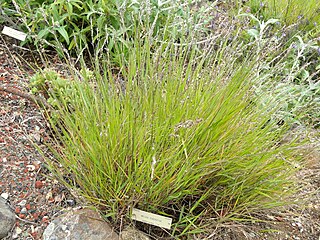Hopia obtusa is a species of grass commonly known as vine mesquite. This plant was treated as Panicum obtusum until recently when more molecular and genetic material revealed new information about it. Hopia obtusa is now placed in the monotypic genus Hopia.
Melica argyrea is a species of grass found in Argentina, Brazil, and Uruguay.

Melica amethystina is a grass species in the family Poaceae that can be found in southern Europe.
Melica argentata is a species of grass endemic to Chile.
Melica longiflora is a grass species in the family Poaceae that is endemic to Chile where it can be found from Coquimbo to Talca.
Melica bonariensis is a species of grass endemic to Argentina where it can be found in such provinces as Buenos Aires, La Pampa, and Rio Negro.
Melica brasiliana, is a grass species in the family Poaceae that is endemic to Brazil and southern South America.
Melica subflava, is a species of grass that is endemic to China.

Melica teneriffae, is a grass species in the family Poaceae that is endemic to the Canary Islands.
Melica spartinoides, is a species of grass in the family Poaceae that is endemic to the Brazilian state of Santa Catarina.
Melica serrana, is a species of grass endemic to Cerro de las Ánimas, Uruguay.
Melica stuckertii, is a grass species in the family Poaceae that is endemic to Argentina and southern South America.
Melica hyalina is a species of grass found in Brazil and southern South America.
Melica kozlovii is a species of grass found on mountain slopes in Mongolia and China at 2,000–3,900 metres (6,600–12,800 ft) above sea level.
Melica paulsenii is a species of grass endemic to Chile where it grows along the coastal cordillera at 50–700 metres (160–2,300 ft) above sea level.
Melica minuta is a species of grass that can be found in the Mediterranean Basin, from Portugal and Morocco to the Eastern Mediterranean.
Melica patagonica is a species of grass that is endemic to South America.
Melica parodiana is a species of grass found in Buenos Aires, Argentina and Uruguay.
Melica radula is a species of grass endemic to China. It grows on grassy mountain slopes and larch forests at 300–1,200 metres (980–3,940 ft) above sea level.

Melica penicillaris is a species of grass in the Poaceae family. It is endemic to Inner Anatolia, Turkey, where it grows on bushy hills, rocky slopes, limestone surfaces, and in gullies at 1,000–1,800 metres (3,300–5,900 ft) above sea level.


